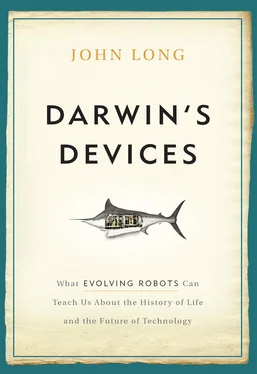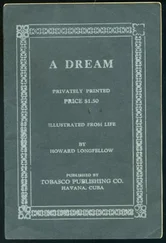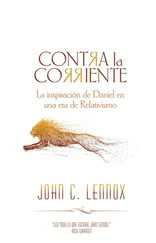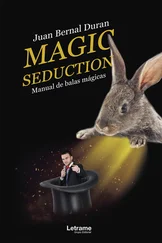DESIGN QUESTION 1. WHICH ANIMAL WILL WE MODEL AND WHY?
We want to model the mother of all vertebrates—literally. We want the ancestor from whom all other vertebrates evolved. The only problem with this desire is that we don’t know exactly who that ancestor was or what exactly she looked like. The origins of vertebrates are shrouded in mystery (soundtrack: key low Celtic whistle). What to do?
This mystery drives crazy anyone who cares about deep evolutionary history: who were the first vertebrates, anyway? This simple question turns out to be controversial because the information that we use keeps being updated and revised. Damn those meddling scientists! We find new fossils, analyze new genes, and come up with different computer methods to reconstruct evolutionary relationships among species. [14] If you are interested, these issues are addressed in the fast-paced fields of phylogenetics, phylogenomics, and evolutionary developmental biology.
Some of the newest information about vertebrate evolution when we were trying to answer this question had come from the laboratory of Frédéric Delsuc at Montreal University. [15] In the mid-naughties—2000s—the flux in our understanding of evolutionary relationships was widely recognized in college-level textbooks. For an excellent example, see Chapter 1 in Michael J. Benton, Vertebrate Paleontology, 3rd ed. (Malden, MA: Blackwell Science, 2005). Also, Frédéric Delsuc, Henner Brinkmann, Daniel Chourrout, and Hervé Philippe, “Tunicates and Not Cephalochordates Are the Closest Living Relatives of Vertebrates,” Nature 439, no. 7079 (2006): 965–968. This then-radical view has been tentatively accepted (but still subject to revision as new data are generated), particularly in light of new information on the genome of cephalochordates. See Peter W. H. Holland, “From Genomes to Morphology: A View from Amphioxus,” Acta Zoologica 91, no. 1 (2010): 81–86.
Delsuc and his colleagues examined 146 genes in forty species of living animals, using the similarity among the genes to cluster species into related groups. The group that clustered closest to the vertebrates was the tunicates and not a group called lancelets. This result was a surprise because adult lancelets look and behave like zippy little fish whereas some adult tunicates go by the name “sea squirt” because they are little grape-like balls attached to rocks at low tide who squirt water at finger-poking people (Figure 3.2). [16] Tunicates (also called ascidians and urochordates) are members of the Phylum Chordata, a group of related species that also contains vertebrates and lancelets. Lancelets, also called amphioxus (species name Branchiostoma ), are members of the Cephalochordata. For an excellent comparison of these two groups in the context of vertebrate origins, see M. Schubert, H. Escriva, J. Xavier-Neto, and V. Laudet, “Amphioxus and Tunicates as Evolutionary Model Systems,” Trends in Ecology and Evolution 21, no. 5 (2006): 269–277.
In technical terms, any two species or groups of species that are more closely related to each other than they are to any other species or group of species are called “sister taxa,” where the term “taxa” is the plural form of “taxon,” which means any group of related organisms.
How can it be that a bag of water is the sister taxon to vertebrates? Even though adult tunicates are ugly bags of mostly water, [17] The phrase “ugly bags of mostly water” was a first-contact description of humanoids uttered by a crystalline life-form in the Star Trek: The Next Generation episode “Home Soil” (season 1). If these crystalline life-forms had seen adult tunicates and humanoids side by side, I’m guessing that they would’ve called the former bags and the latter, more accurately, tubes or branched cylinders.
the pre-adult larvae of tunicates look like zippy little fish, sporting a sensor-filled front end and a long tail flexing with undulatory waves that push water backward and, by Newton’s third law, the larva forward. This resemblance of the larval form of tunicates to the adult form of fish has long been recognized. Walter Garstang, working in the first half of the twentieth century, proposed the then-radical idea that because the larvae of some species were more similar to the adults of others, we needed to consider the possibility that evolution might have worked by chopping off the adult stage to create new adult forms. In fact, back in 1928 Garstang proposed the idea that the larvae of ancient tunicates might have provided the basic vertebrate body plan—seventy-eight years before Delsuc’s molecular data suggested the same thing. [18] Walter Garstang, “The Morphology of the Tunicata, and Its Bearing on the Phylogeny of the Chordata,” Quarterly Journal of Microscopical Science 62 (1928): 51–187. In one of those beautiful, accidental collusions between science and art, his scientific ideas are immortalized in his poetry, published posthumously in 1951 as Larval Forms and Other Zoological Verses (Oxford: Blackwell).
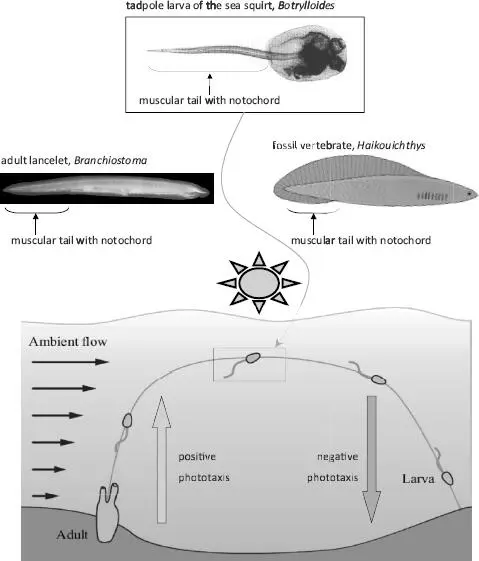
FIGURE 3.2. Modeling the first vertebrates. Biologists use three different kinds of animals to infer what the first vertebrates might have been like. Sea squirts (three millimeters long as free-swimming larvae of the genus Botrylloides ) and lancelets (about four millimeters long as free-swimming larvae of the genus Branchiostoma ; twenty-two millimeters long as adults shown here) are living invertebrate members of the Phylum Chordata, the taxon that includes vertebrates. Haikouichthys is a fossil fish (about thirty millimeters long) from oceans 530 million years ago and are the earliest complete vertebrates of which we know. All three animals bear a muscular tail with a notochord for a skeleton. Sea squirts have one plan in mind: swim toward the light (positive phototaxis) and away from your parent, and then swim away from the light (negative phototaxis) and find a new place to live and turn into an adult. Images of sea squirts copyright © 2010 Matt McHenry. Interpretation of Haikouichthys based on fossil evidence (from Wikipedia Commons: Giant Blue Anteater grants anyone the right to use this work for any purpose, without any conditions, unless such conditions are required by law. ). Image of Branchiostoma licensed by Hans Hillewaert under the Creative Commons Attribution-Share Alike 2.5 Generic license.
Warning: sloppy-thinking watch in effect. Evolutionary intuitions may cloud inferential cognitive processes. Keep in mind that when we look at the living tadpole larvae of sea squirts, we aren’t looking at the ancestor of vertebrates, even if tunicates and vertebrates are sister taxa. Living tunicates have had at least 530 million years of evolution on their own, after they split with vertebrates, to create their own family lineage. Thinking that every living species is an ancestor of another living species is a common fallacy, what I’ll call the fallacy of the living ancestor.
Secondary warning: the fallacy of the living ancestor has a conceptual sibling, the fallacy of the fossil ancestor. “Paleontology is the search for ancestors,” allegedly claimed George Gaylord Simpson, one of the greatest paleontologists and a cofounder of the modern synthesis of evolutionary biology. But he was wrong. (Did I just say that? Forgive me, G. G.!) The chance that you’ll actually find any ancestor is very small for two reasons. First, the fossil record is incomplete. The accidental mudslides and burials that turn animals into fossils capture only a small percentage of the animals that are alive. In addition, we have good evidence that new species are usually created from small, breakaway bands of a main population; the number of these founding individuals just aren’t numerous enough to be reliably fossilized and then found millions of years later. Probability of finding the actual ancestor of any living species: approaching zero.
Читать дальше
